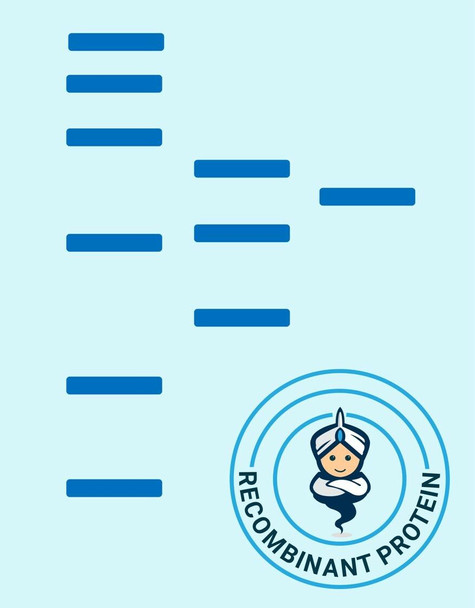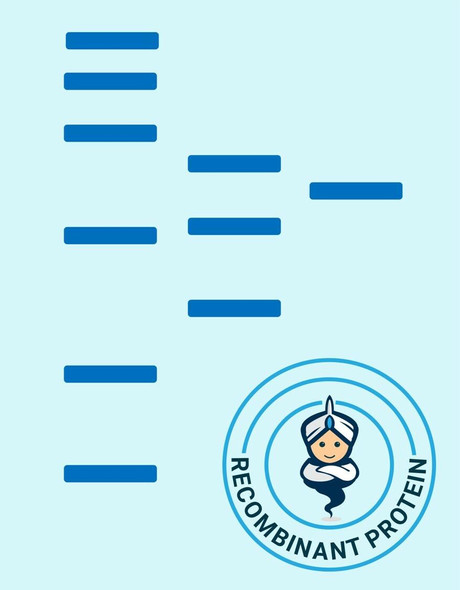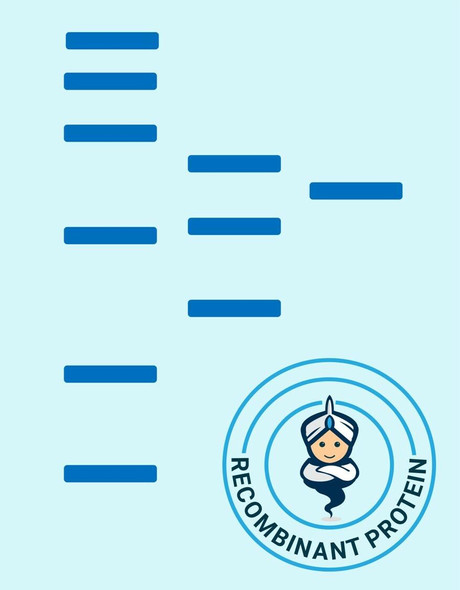Human EREG Recombinant Protein (RPPB0185)
- SKU:
- RPPB0185
- Product type:
- Recombinant Protein
- Size:
- 25ug
- Species:
- Human
- Target:
- EREG
- Synonyms:
- EREG
- Epiregulin
- ER
- Source:
- Escherichia Coli
- Uniprot:
- O14944
Description
| Product Name: | Human EREG Recombinant Protein |
| Product Code: | RPPB0185 |
| Size: | 25µg |
| Species: | Human |
| Target: | EREG |
| Synonyms: | EREG, Epiregulin, ER. |
| Source: | Escherichia Coli |
| Physical Appearance: | Sterile Filtered White lyophilized (freeze-dried) powder. |
| Formulation: | Epiregulin was lyophilized from 0.5mg/ml solution ciontaing 20mM PBS buffer pH-7.4 containing 130mM sodium chloride. |
| Solubility: | It is recommended to reconstitute the lyophilized Epiregulin in sterile 18M?-cm H2O not less than 100µg/ml, which can then be further diluted to other aqueous solutions. |
| Stability: | Lyophilized Epiregulin although stable at room temperature for 3 weeks, should be stored desiccated below -18°C. Upon reconstitution Epiregulin should be stored at 4°C between 2-7 days and for future use below -18°C.For long term storage it is recommended to add a carrier protein (0.1% HSA or BSA).Please prevent freeze-thaw cycles. |
| Purity: | Greater than 97.0% as determined by:(a) Analysis by RP-HPLC.(b) Analysis by SDS-PAGE. |
| Amino Acid Sequence: | MVAQVSITKC SSDMNGYCLH GQCIYLVDMS QNYCRCEVGY TGVRCEHFFL |
| Biological Activity: | The ED50 was determined by the dose-dependent stimulation of the proliferation of murine Balb/3T3 cells is < 2.0 ng/ml, corresponding to a specific activity of > 500,000 units/mg. |
Epiregulin is part of the EGF family. Epiregulin functions as a ligand of EGFR, as well as a ligand of most members of the ERBB (v-erb-b2 oncogene homolog) family of tyrosine-kinase receptors.Epiregulin is expressed mostly in the placenta and peripheral blood leukocytes and in specific carcinomas of the bladder, lung, kidney and colon. Epiregulin stimulates the proliferation of keratinocytes, hepatocytes, fibroblasts and vascular smooth muscle cells. Epiregulin inhibits the growth of several tumor-derived epithelial cell lines. Human Epiregulin is initially synthesized as a glycosylated 19.0 kDa transmembrane precursor protein, which is processed by proteolytic cleavage to produce a 6.0 kDa mature secreted sequence.
Epiregulin Human Recombinant produced in E.Coli is a single, non-glycosylated, polypeptide chain containing 50 amino acids and having a molecular mass of 6 kDa. Epiregulin is purified by proprietary chromatographic techniques.
| UniProt Protein Function: | Epiregulin: Ligand of the EGF receptor/EGFR and ERBB4. May be a mediator of localized cell proliferation. As a mitogen it may stimulate cell proliferation and/or angiogenesis. |
| UniProt Protein Details: | Protein type:Membrane protein, integral Chromosomal Location of Human Ortholog: 4q13.3 Cellular Component: extracellular space; integral to plasma membrane; extracellular region Molecular Function:protein binding; growth factor activity; epidermal growth factor receptor binding Biological Process: response to peptide hormone stimulus; nerve growth factor receptor signaling pathway; wound healing; activation of MAPK activity; positive regulation of smooth muscle cell proliferation; positive regulation of interleukin-6 biosynthetic process; female meiosis; negative regulation of smooth muscle cell differentiation; negative regulation of cell proliferation; primary follicle stage, oogenesis; positive regulation of fibroblast proliferation; cell-cell signaling; positive regulation of epidermal growth factor receptor activity; positive regulation of cell proliferation; positive regulation of innate immune response; ovarian cumulus expansion; angiogenesis; negative regulation of epithelial cell proliferation; positive regulation of cytokine production; epidermal growth factor receptor signaling pathway; anatomical structure morphogenesis; fibroblast growth factor receptor signaling pathway; phosphoinositide-mediated signaling; positive regulation of mitosis; cytokine and chemokine mediated signaling pathway; positive regulation of cytokine biosynthetic process; luteinizing hormone signaling pathway; keratinocyte proliferation; oocyte maturation; keratinocyte differentiation; ovulation; organ morphogenesis; positive regulation of protein kinase activity; mRNA transcription; innate immune response; negative regulation of transcription, DNA-dependent; positive regulation of phosphorylation; positive regulation of DNA replication |
| NCBI Summary: | Epiregulin is a member of the epidermal growth factor family. Epiregulin can function as a ligand of EGFR (epidermal growth factor receptor), as well as a ligand of most members of the ERBB (v-erb-b2 oncogene homolog) family of tyrosine-kinase receptors. [provided by RefSeq, Jul 2008] |
| UniProt Code: | O14944 |
| NCBI GenInfo Identifier: | 8134446 |
| NCBI Gene ID: | 2069 |
| NCBI Accession: | O14944.1 |
| UniProt Secondary Accession: | O14944,Q6FH69, B2RC66, |
| UniProt Related Accession: | O14944 |
| Molecular Weight: | 19,044 Da |
| NCBI Full Name: | Proepiregulin |
| NCBI Synonym Full Names: | epiregulin |
| NCBI Official Symbol: | EREG |
| NCBI Official Synonym Symbols: | ER |
| NCBI Protein Information: | proepiregulin |
| UniProt Protein Name: | Proepiregulin |
| Protein Family: | Proepiregulin |
| UniProt Gene Name: | EREG |
| UniProt Entry Name: | EREG_HUMAN |










